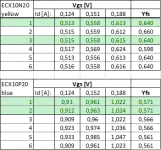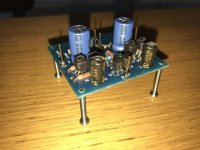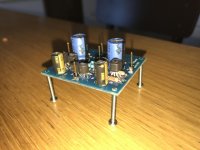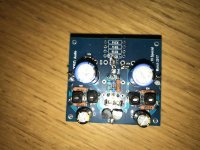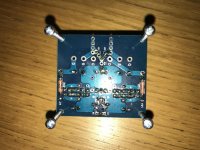UTHAiM as IV Converter
Something reminded me of the current convey nature of the UTHAiM.
So how about using it as an IV Converter ?
The Spice files show an IV using a current out DAC at 1mA and Vref=0, as an example.
Output is set by Riv (R3) to 2Vrms.
It is deliberately shown without Civ, in order to make the bandwidth of the circuit itself visible.
So the Civ show be added accordingly.
The output at R3 (Out1) is practically distortion free.
If the load is 10k or above, you can skip the lateral FETs and just use a JFET follower as buffer (e.g. 2x 2SK170BL).
But you can also attach a 300~600R headamp directly to the MOSFET output.
And you can simply use a switched resistor pot for R3 as volume control.
So much fun,
Patrick
.
Something reminded me of the current convey nature of the UTHAiM.
So how about using it as an IV Converter ?
The Spice files show an IV using a current out DAC at 1mA and Vref=0, as an example.
Output is set by Riv (R3) to 2Vrms.
It is deliberately shown without Civ, in order to make the bandwidth of the circuit itself visible.
So the Civ show be added accordingly.
The output at R3 (Out1) is practically distortion free.
If the load is 10k or above, you can skip the lateral FETs and just use a JFET follower as buffer (e.g. 2x 2SK170BL).
But you can also attach a 300~600R headamp directly to the MOSFET output.
And you can simply use a switched resistor pot for R3 as volume control.
So much fun,
Patrick
.
Attachments
A little progress after quite a while. I received the Exicon ECX lateral FETs yesterday and now I got them measured according to EUVL's instructions in post #39. I have attached my measurement results and marked with green color the ones that I chose to be used in my build.
So the next step will be according to my understanding to calculate the values for R21 and R21 as shown in the guide in the first post:
R21 = (Vgs_ECX10N20 + R31 x I_bias) / Idss_JFET = (0,558 V + 0) / 8,2 mA = 68 ohm
I suppose I can leave out the R31 and replace it with a jumper? I don't have a scope for measuring the second harmonics.
R22 = (Vgs_ECX10P20) / Idss_JFET = 0,961 V / 8,2 mA = 117 ohm
So I choose closest standard value resistor and then trim them by minimizing the DC offset. I hope I got all of this right...
So the next step will be according to my understanding to calculate the values for R21 and R21 as shown in the guide in the first post:
R21 = (Vgs_ECX10N20 + R31 x I_bias) / Idss_JFET = (0,558 V + 0) / 8,2 mA = 68 ohm
I suppose I can leave out the R31 and replace it with a jumper? I don't have a scope for measuring the second harmonics.
R22 = (Vgs_ECX10P20) / Idss_JFET = 0,961 V / 8,2 mA = 117 ohm
So I choose closest standard value resistor and then trim them by minimizing the DC offset. I hope I got all of this right...
Attachments
Let's use Morde's data as an exercise.
In this particular case, the P channel has a higher Yfs than the N channel.
The difference in 1/Yfs is 0.19 ohm.
So if we wish to have equal AC current sharing between the two MOSFETs, R31 should be ~0.19ohm, and assigned to the P-channel.
That means e.g. 3x 0.56ohm in parallel (e.g. Mouser 279-LR1LJR56).
And J22 should be shorted instead of J21.
R21 = (Vgs_ECX10N20) / Idss_JFET = 0.558V / 8.2 mA = 68 ohm
R22 = (Vgs_ECX10P20 + R31 x I_bias) / Idss_JFET = (0.961V +0.19*0.15) / 8,2 mA = 121 ohm
Patrick
In this particular case, the P channel has a higher Yfs than the N channel.
The difference in 1/Yfs is 0.19 ohm.
So if we wish to have equal AC current sharing between the two MOSFETs, R31 should be ~0.19ohm, and assigned to the P-channel.
That means e.g. 3x 0.56ohm in parallel (e.g. Mouser 279-LR1LJR56).
And J22 should be shorted instead of J21.
R21 = (Vgs_ECX10N20) / Idss_JFET = 0.558V / 8.2 mA = 68 ohm
R22 = (Vgs_ECX10P20 + R31 x I_bias) / Idss_JFET = (0.961V +0.19*0.15) / 8,2 mA = 121 ohm
Patrick
I'm using Audeze LCD 2.2F (Fazor) headphones. They are quite sensitive (101dB/mW) and have a static impedance of 70 ohm throughout the frequency range. Possibly I will aquire a pair of Sennheiser HD800S phones too at some point - after I rob a bank. =)
I'll use a piece of wire for J22. Or is it actually J32 as it reads on my boards?
I'll use a piece of wire for J22. Or is it actually J32 as it reads on my boards?
I think I have some problems while testing the front end without the lateral FETs. I measure 6,9 V across R7/R8 and 0V across R5/R6. The voltage across R11 is 12,6 V. I suppose there's something wrong with the positive voltage side of the boards. The error is systematic as it is present in both boards. Rail voltages are +-23,4 V.
Any help with error finding is highly appreciated! I attached few pictures of one board if it helps.
Any help with error finding is highly appreciated! I attached few pictures of one board if it helps.
Attachments
Last edited:
Before you do anything, please clean off all the flux residuals with a PCB cleaner.
Did you short the input to Gnd during test ?
What are the voltages across the 4x 499R at the front end ?
They should be 499R x 8.2mA = 4.1V, all 4 of them, if the current mirrors are working properly.
Patrick
Did you short the input to Gnd during test ?
What are the voltages across the 4x 499R at the front end ?
They should be 499R x 8.2mA = 4.1V, all 4 of them, if the current mirrors are working properly.
Patrick
Still, clean the board until there is no fluke residual left.
soldering - Why do we need to remove flux from circuit boards? - Electrical Engineering Stack Exchange
Patrick
soldering - Why do we need to remove flux from circuit boards? - Electrical Engineering Stack Exchange
Patrick
I have now one channel's front end DC balanced. Voltage across R11 goes from -17 mV at starting point to hovering 0...-4 mV after 15 min. I suppose it is normal for the voltage to move a bit? I hope this is a good enough result.
Next I will have to wait for a couple of reistors to arrive so I can continue with second channel's front end and after that the output DC balancing. Should I have the input shorted to ground when I trim the output DC offset?
Next I will have to wait for a couple of reistors to arrive so I can continue with second channel's front end and after that the output DC balancing. Should I have the input shorted to ground when I trim the output DC offset?
- Home
- Amplifiers
- Headphone Systems
- UTHAiM -- Just for Fun
